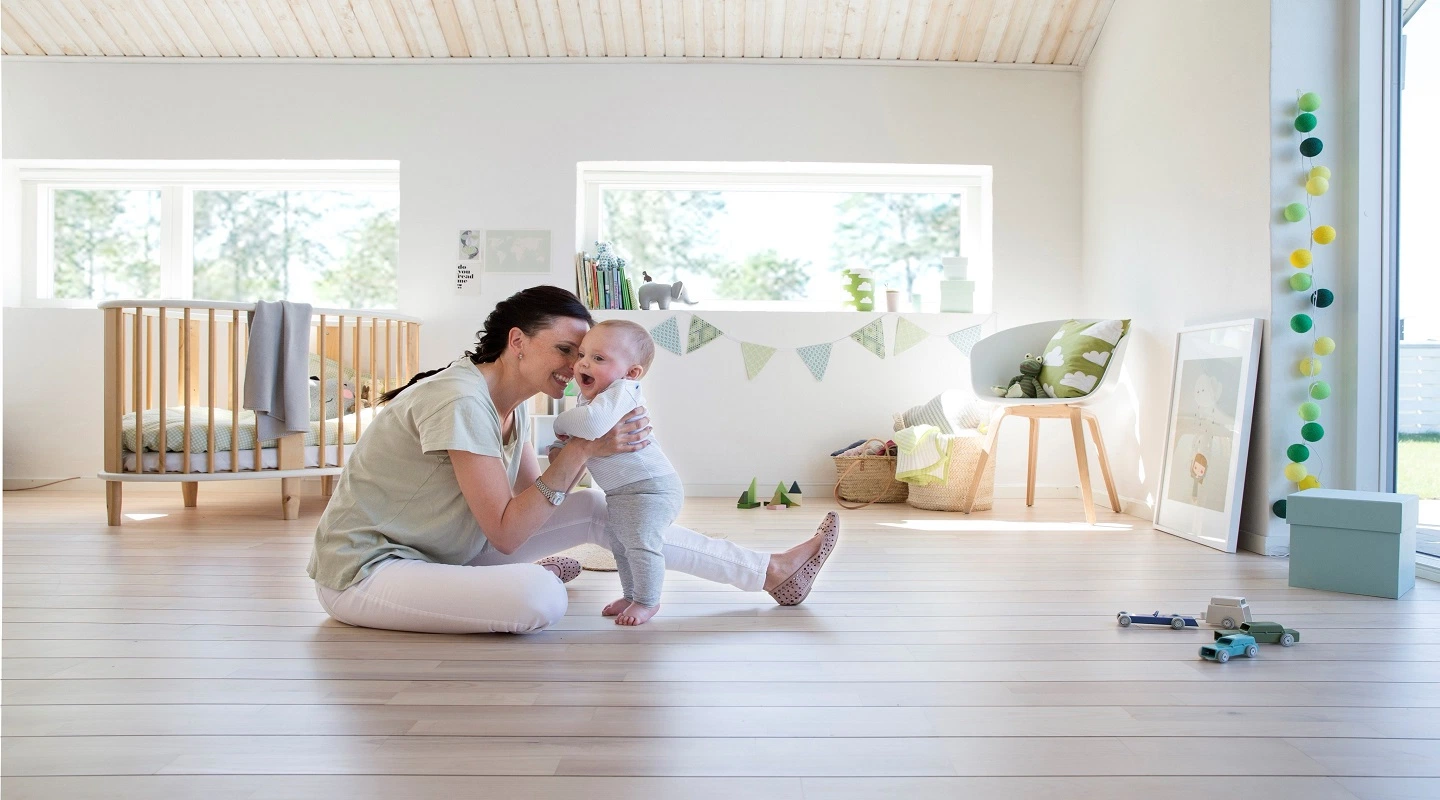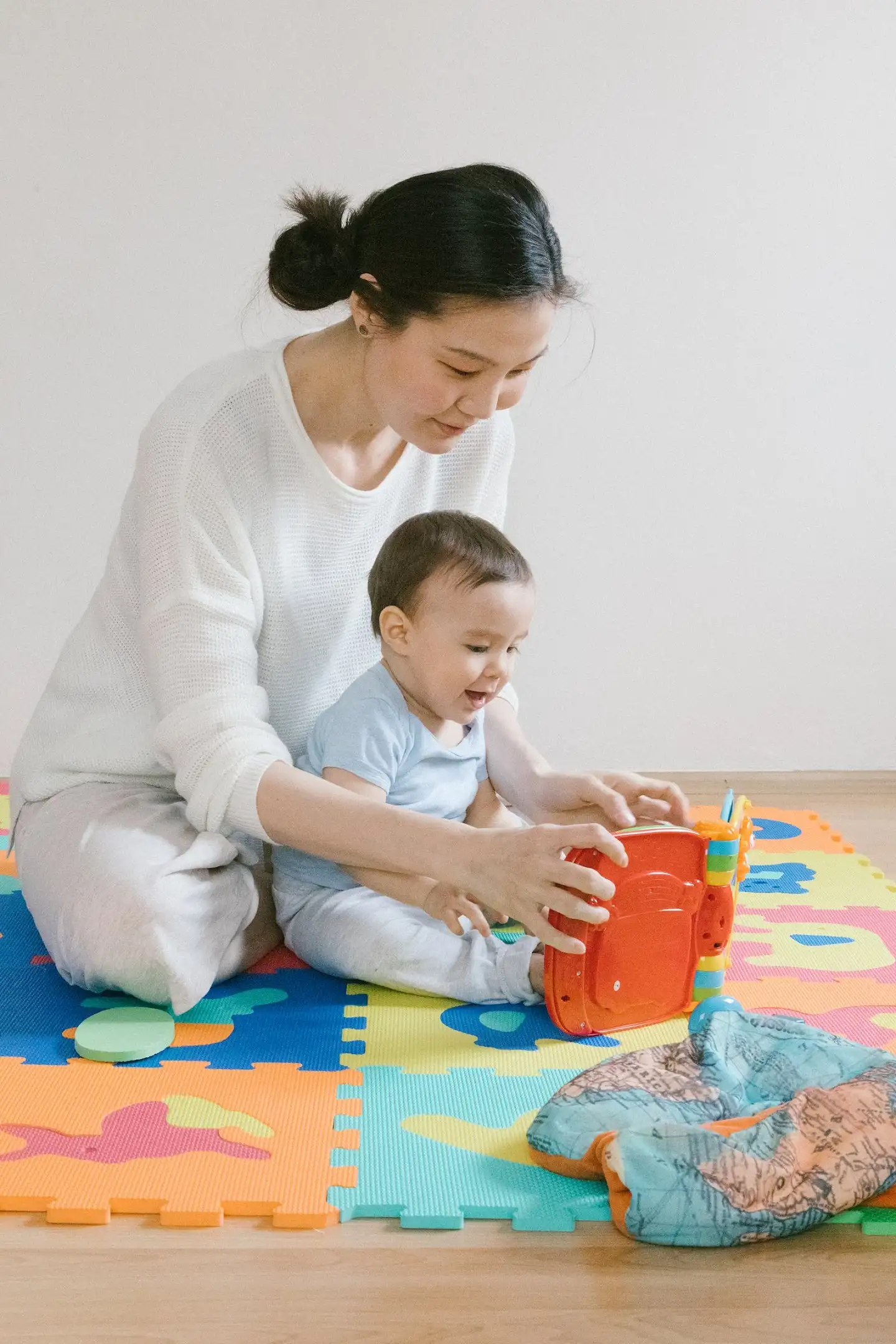Safest Flooring for Babies: Creating a Secure and Nurturing Environment

The journey of parenthood is a remarkable adventure filled with precious moments of discovery and growth. Parents’ top priority is ensuring the safety and well-being of their little ones at every step. When creating a safe haven for babies and toddlers, the significance of choosing the right flooring cannot be overstated. The floor beneath their tiny feet becomes a playground, a learning space, and a foundation for their earliest milestones. With this in mind, selecting the safest flooring for babies is a decision that holds great weight, shaping their early experiences and offering peace of mind to caregivers.
Factors to Consider in Choosing Flooring for Babies

1. Healthy Indoor Environment: The quest for the safest flooring for babies begins with a commitment to fostering a healthy indoor environment. Infants and toddlers have developing respiratory systems that make them more susceptible to the effects of indoor air pollutants. Thus, opting for flooring materials low in volatile organic compounds (VOCs) and other harmful chemicals is paramount. VOCs, commonly found in adhesives and finishes used in some flooring types, can emit gases contributing to indoor air pollution and potentially impacting respiratory health. Parents can make a safer place for their little ones to prevent them from inhaling harmful substances by selecting low or no-VOC-content flooring.
Furthermore, choosing flooring materials plays a crucial role in preventing the accumulation of allergens and irritants. Babies often come into direct contact with the floor, and allergens trapped in carpet fibers or other flooring materials can trigger allergic reactions or respiratory discomfort. Choosing easy-to-clean flooring that doesn’t harbor dust mites, pet dander, or other allergens is essential to ensure that the environment in which babies explore and play remains clean, fresh, and conducive to their overall well-being. As caregivers, the conscious decision to prioritize a healthy indoor environment through the choice of flooring reflects a commitment to providing our little ones with the best start in life.
2. Allergen Resistance: When it comes to safeguarding the health and comfort of babies, considering allergen resistance in flooring choices is paramount. Infants and toddlers have delicate immune systems that can be sensitive to allergens, and their proximity to the floor places them at a higher risk of exposure. Opting for allergen-resistant flooring materials can help mitigate potential health issues and create a safer living environment.
Certain flooring options, such as carpets with deep fibers, tend to trap allergens like dust mites, pet dander, and pollen. These allergens can exacerbate allergies or even trigger respiratory problems. To counteract this, selecting easy-to-clean flooring materials with smooth, non-porous surfaces can significantly reduce the accumulation of allergens. Hard surfaces like hardwood, vinyl, or rubber are generally better in this regard, as they can be more effectively cleaned and maintained.
Parents can provide their babies with a healthier, more comfortable space to explore and grow by focusing on allergen resistance. This consideration is particularly crucial for families with members who have allergies or asthma, as it contributes to a harmonious environment where both infants and caregivers can thrive without the added burden of allergen-related concerns.
Explore the best quality flooring material types that match every home due to their color variety.
3. Ease of Cleaning: The whirlwind of babyhood often involves unexpected spills, messy feedings, and inevitable accidents. Choosing flooring that is easy to clean is a practical necessity for parents. When babies are on the move, having a surface that can be swiftly and effectively cleaned ensures a hygienic environment and reduces stress. Smooth, non-absorbent flooring materials like hardwood, vinyl, and rubber can be quickly wiped down, preventing stains and minimizing lingering odors. This ease of cleaning maintains the overall cleanliness of the living space. It supports a healthier setting where babies can explore freely without constant concern for the aftermath of spills and messes.
4. Budget Considerations: Parenthood comes with many financial responsibilities, and choosing the safest flooring for babies should align with your budget. Fortunately, a range of flooring options cater to various financial considerations. While some premium materials might be enticing, balancing safety, quality, and affordability is essential. Researching cost-effective alternatives that meet safety and hygiene criteria can lead to a well-informed decision. By considering your budget, you can ensure that your baby’s environment remains secure without putting unnecessary strain on your finances, allowing you to focus on creating a nurturing space that supports their early development.
5. Room-Specific Flooring: Different rooms have distinct requirements, and tailoring the flooring to each space enhances safety and functionality. For example, moisture-resistant options like vinyl are suitable for bathrooms, while soft carpeting provides comfort in bedrooms and playrooms. Understanding the specific needs of each room ensures that your flooring meets safety standards and complements the room’s purpose. This thoughtful approach optimizes the environment for your baby’s activities and contributes to an organized and cohesive living space that adapts to their evolving needs.
6. Noise Reduction: The impact of flooring goes beyond physical safety—it also influences the acoustic environment. Opting for noise-reducing flooring materials can create a tranquil space for babies and caregivers. Materials like carpet and rubber possess sound-absorbing properties, minimizing echoes and footsteps. This becomes especially relevant in playrooms and bedrooms, where a peaceful atmosphere supports better sleep and concentration. By mitigating noise, you cultivate a soothing environment that contributes to your baby’s overall well-being while providing a more serene setting for family activities and interactions.
7. Softness and Resilience: The comfort and safety of your baby’s explorations depend on the softness and resilience of the chosen flooring. Soft surfaces like carpet, foam tiles, and rubber offer gentle cushioning for tiny knees and hands, ensuring a cozy play area. Additionally, resilient flooring materials absorb the impact of falls, reducing the risk of injury. These attributes are crucial during the developmental phases when crawling and wobbly first steps are common. By selecting flooring that prioritizes softness and resilience, you create an environment that encourages movement, confidence, and the joy of discovery while minimizing potential accidents.
How to find the best non-slip stairs flooring? Is laminate the best option to floor the stairs?
Exploring Flooring Options for Babies

1. Carpet: Soft and inviting carpets offer a plush surface for babies to crawl and play. Their sound-absorbing qualities make them perfect for bedrooms and playrooms. Opt for low-pile carpets that resist allergens and are easy to clean, ensuring a cozy and hygienic space.
2. Hardwood: Timelessly elegant, hardwood floors can be enhanced for baby-friendliness. Incorporate soft area rugs for cushioning and warmth in nurseries and living areas, maintaining the sophisticated appeal while providing a comfortable environment for your little one.
3. Vinyl: Practicality shines with vinyl flooring. Its water-resistant nature and easy maintenance make it a convenient choice for spaces prone to spills, like kitchens and bathrooms. Choose low-VOC options to uphold indoor air quality while benefiting from vinyl’s durability and versatility.
4. Rubber: Emphasizing safety and resilience, rubber flooring excels in active play areas like playrooms. Its shock-absorbent properties cushion falls, making it a top contender for creating secure environments where babies can explore and learn while minimizing the risk of injuries.
Tip: What is the best flooring for kids?
Conclusion

Choosing the safest flooring for babies and toddlers is a multidimensional decision that merges practicality with the nurturing environment every parent aspires to create. As caregivers, we strive to provide spaces where our little ones can thrive, explore, and learn without compromising their safety and well-being. This journey makes us consider many factors, from maintaining a healthy indoor environment free from allergens to accommodating room-specific needs.
Prioritizing easy-to-clean surfaces, budget considerations, noise reduction, and the crucial balance between softness and resilience ensure that the chosen flooring meets the evolving demands of early childhood. Whether it’s the gentle embrace of carpet, the timeless charm of hardwood, the practicality of vinyl, or the cushioning resilience of rubber, each flooring option serves as a canvas upon which our babies’ first adventures unfold.
By weaving together these considerations, parents forge an environment where little feet can confidently explore, curious minds can roam freely, and safety is woven into their surroundings. Ultimately, the choice of flooring becomes a tangible expression of love and care, reflecting a commitment to providing the best possible start for the newest members of our families. Through careful consideration and informed decisions, we lay the foundation for a world of discovery, growth, and joy for our beloved babies.



Did you find what you were looking for?